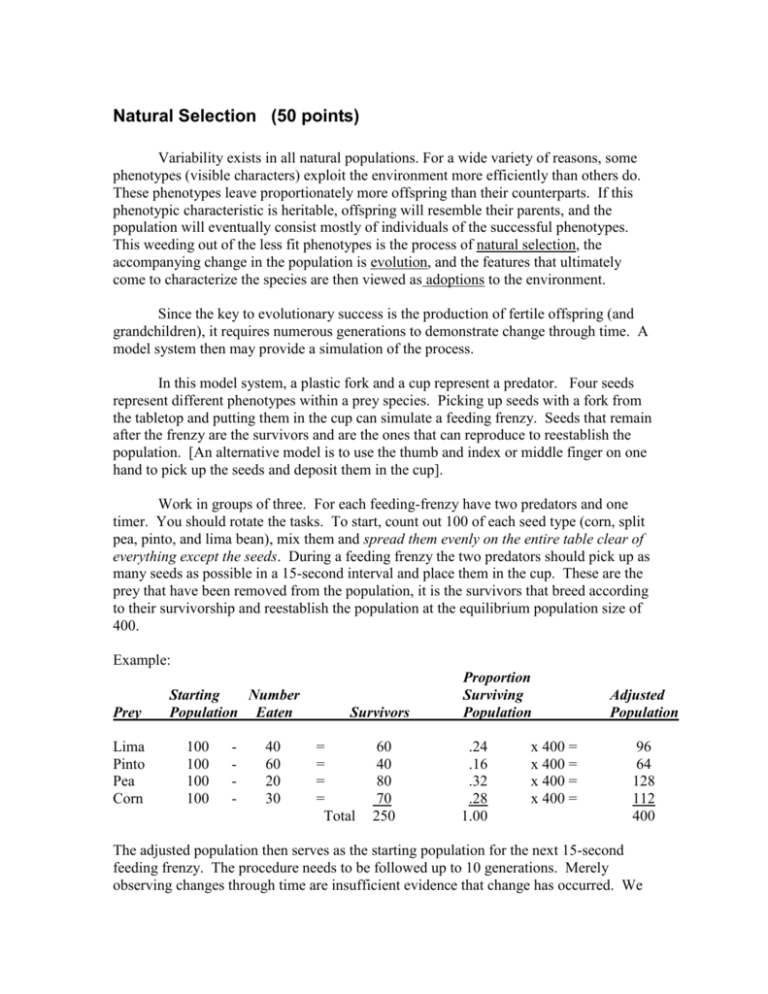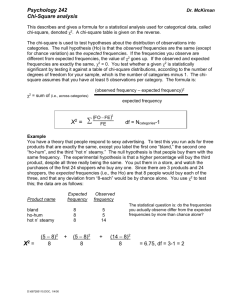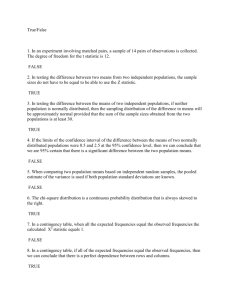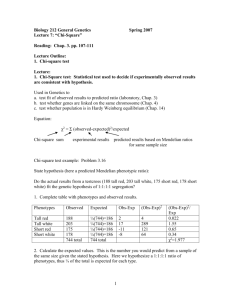Natural Selection (50 points)
advertisement

Natural Selection (50 points) Variability exists in all natural populations. For a wide variety of reasons, some phenotypes (visible characters) exploit the environment more efficiently than others do. These phenotypes leave proportionately more offspring than their counterparts. If this phenotypic characteristic is heritable, offspring will resemble their parents, and the population will eventually consist mostly of individuals of the successful phenotypes. This weeding out of the less fit phenotypes is the process of natural selection, the accompanying change in the population is evolution, and the features that ultimately come to characterize the species are then viewed as adoptions to the environment. Since the key to evolutionary success is the production of fertile offspring (and grandchildren), it requires numerous generations to demonstrate change through time. A model system then may provide a simulation of the process. In this model system, a plastic fork and a cup represent a predator. Four seeds represent different phenotypes within a prey species. Picking up seeds with a fork from the tabletop and putting them in the cup can simulate a feeding frenzy. Seeds that remain after the frenzy are the survivors and are the ones that can reproduce to reestablish the population. [An alternative model is to use the thumb and index or middle finger on one hand to pick up the seeds and deposit them in the cup]. Work in groups of three. For each feeding-frenzy have two predators and one timer. You should rotate the tasks. To start, count out 100 of each seed type (corn, split pea, pinto, and lima bean), mix them and spread them evenly on the entire table clear of everything except the seeds. During a feeding frenzy the two predators should pick up as many seeds as possible in a 15-second interval and place them in the cup. These are the prey that have been removed from the population, it is the survivors that breed according to their survivorship and reestablish the population at the equilibrium population size of 400. Example: Prey Lima Pinto Pea Corn Starting Number Population Eaten 100 100 100 100 - 40 60 20 30 Survivors = = = = Total 60 40 80 70 250 Proportion Surviving Population .24 .16 .32 .28 1.00 x 400 = x 400 = x 400 = x 400 = Adjusted Population 96 64 128 112 400 The adjusted population then serves as the starting population for the next 15-second feeding frenzy. The procedure needs to be followed up to 10 generations. Merely observing changes through time are insufficient evidence that change has occurred. We thus need to provide statistical evidence that can be provided using a simple chi-square test. Read the accompanying description of the chi-square procedure. Propose an appropriate hypothesis for your model run and then determine the level of significance following the first, fifth, and final generations. Also graph the adjusted population size of each phenotype (on a single plot) for each generation. Start with generation zero that has 100 of each type. Incorporate these requirements into your formal write-up of this experiment. Required information to include in the paper: hypothesis (introduction), use of chisquared (methods and materials), table of % values for each generation (results), table of chi-squared values following first, fifth, and final generations and the level of significance (results), single plot that shows the population sizes over the course of the experiment. Include all parts of a paper Intro, Methods Results Discussion, Lit cited. Chi-square A relatively simple yet powerful test often used in science is the Chi-square analysis. Essentially, this is the statistical assessment of how well actual data fits an expected pattern. For example, suppose a scientist raises 100 plants and, because of the laws of genetics, predicts a 3:1 ratio of yellow to blue flowers (75 yellow, 25 blue). The actual ratio was 84 yellow: 16 blue. The statistical question is: Are the "observed" frequencies (84 to 16) significantly different from the "expected" frequencies (75 to 25)? Testing this question using the Chi-square method proceeds as follows: 2 X 2 = (O E )2 E Where X is the Chi-square value, O is the observed frequency, E is the expected frequency, and is the symbol for summation over k categories. In this example, there are two categories: yellow flower color and blue flower color. In order to determine the 2 significance of the X value, you must also determine the number of degrees of freedom for the problem. Degrees of freedom (df) refer to how many values have to be known to know all of the values in a problem. In this case, the degrees of freedom is k-1, which means that if you know all but one of the values for the categories, you will know the other (i.e., if you know that out of 100 plants, 84 are yellow, then 16 must be blue if that's the only other flower color - k = 2, so 2 - 1 = 1 df). 2 So, calculations of X may be summarized as follows: Category (Flower Color) __________________________________________________ Yellow Blue n __________________________________________________ Observed (O) Expected (E) 84 75 16 100 25 __________________________________________________ df = k-1 = 2-1 = 1 X2 = (O E )2 = (84 75) 2 + (16 25) 2 75 25 E = 92 + 92 75 25 = 1.080 + 3.240 = 4.320 X2 = 4.32 calculated This value is then compared to a tabled value of X2. By convention, this tabled value is usually set at 0.05 (95% level of significance) and the df are determined by the number of categories. Therefore, from the table (Table 4.1) at 0.05 and 1 df.: X2 = 3.84 table Because 4.32 is greater than 3.84, we determine that the numbers we found for flower color are significantly different than what is expected. The observed frequencies (84 and 16) are significantly different than the expected frequencies (75 and 25) at 0.05 level and 1 df. In other words, we are 95% certain that values of 84 yellow and 16 blue flowers came from a sample other than one which has 75 yellow and 25 green flowers. Table 1. Chi-Square Values. ________________________________________________________________________ P Values D.F. 0.10 0.05 0.01 0.005 ____________________________________________________________________________ 1 2.706 3.841 6.635 7.879 2 4.605 5.991 9.210 10.597 3 6.251 7.815 11.345 12.838 4 7.779 9.488 13.277 14.860 5 9.236 11.071 15.086 16.750 6 10.645 12.592 16.812 18.548 7 12.017 14.065 18.475 20.278 8 13.362 15.507 20.090 21.955 9 14.684 16.919 21.666 23.589 10 15.987 18.307 23.209 25.188 11 17.275 19.675 24.725 26.757 12 18.549 21.026 26.217 28.299 13 19.812 22.362 27.688 29.819 14 21.064 23.685 29.141 31.319 15 22.307 24.996 30.578 32.801 ____________________________________________________________________________









